St. Anastasius the Fuller
Feastday: September 7
Death: 304
Martyr from Aquileia, near modern Venice, Italy. A fuller or cloth merchant, Anastasius moved to Salona in Dalmatia, Yugoslavia. There he painted a cross on the door of his shop and was speedily arrested and drowned.
Saint Anastasius the Fuller (died 304) is a Christian saint of the pre-schism Christian Church. Anastasius was a fuller of Aquileia who subsequently moved his business to Salona, although other sources say he went to Spalatum.
He was martyred by being drowned after he had proclaimed his Christian faith openly by painting a cross on his door.
Anastasius is the patron saint of fullers and weavers and his feast day is September 7 (formerly August 26)
Blessed Giovanni Battista Mazzucconi
Also known as
• John Mazzucconi
• Johannes Baptiste Mazzucconi
• John Baptist Mazzucconi
Profile
Priest. Member of the Pontifical Institute for Foreign Missions. Missionary to Papua New Guinea. Martyr.
Born
1 March 1826 in Rancio di Lecco, Italy
Died
7 September 1855 in Woodlark Island, Milne Bay, Papua New Guinea
Beatified
19 February 1984 by Pope John Paul II
Blessed Eugenia Picco
Also known as
• Anna Eugenia Picco
• Maria Angela Picco
Profile
Daughter of Giuseppe Picco, a famous touring musician, and Adelaide del Corno. Because her parents lived on the road, Eugenia was raised for years by her grandparents; however, at one point Adalaide returned alone, Eugenia moved in with her, and from that point grew up in a morally corrupt environment. To escape her mother's house, Eugenia spent part of every day praying at the nearby Basilica of Saint Ambrose. Around the age of 20, Eugenia felt a call to religious life and joined the Congregation of the Little Daughters of the Sacred Hearts of Jesus and Mary in Milan, Italy under the direction of its founder, Venerable Agostino Chieppi; she began her novitiate in Parma, Italy on 26 August 1888, and made her final vows in 1894. Eugenia served as novice mistress, archivist, general secretary, member of the council, and then as Superior General of the Congregation from 1911 until her death in 1921. She suffered throughout her adult life with a degenerative bone disease, and in 1919 it led to the amputation of her right leg. A courageous woman, she enriched the spiritual and cultural formation of the sisters, and was known for her devotion to the Eucharist and her work with the poor, especially children.
Born
8 November 1867 at Cresenzago, Milan, Italy
Died
7 September 1921 at Parma, Italy of natural causes
Beatified
7 October 2001 by Pope John Paul II
Blessed Félix Gómez-Pinto Piñero
Profile
One of four children born to pious farm family; his mother was a Franciscan tertiary, and two of his sisters became Capuchin nuns. Félix joined the Franciscan Friar Minor on 12 May 1886 at the at Pastrana, Spain, making his solemn profession on 16 May 1890. Priest, ordained on 19 May 1894 in Avila, Spain. Missionary to the Philippines where he was imprisoned from 1898 into 1899 during the Philippine fight for independence from Spain. Missionary on the Philippine island of Samar from 1903 to 1913. Served for a few months at the Holy Sepulchre in Jerusalem, and then returned to Spain. Worked with and set an example to Franciscan novices at Pastrana from 1914 to 1917. Missionary to the Philippines from 1919 to 1933, but as his health began to fail, he was forced to return to the convent in Pastrana. During the persecutions of Spanish Civil War, he continued to minister to covert Catholics in the area. Siezed by anti-Christian militiamen, he was ordered to blaspheme against God, Mary and the Church; he refused. His convent hospital was converted by the militia into a prisons; Father Felix was kept their for several days while other priests and brothers were rounded up, and then they were executed. Martyr.
Born
18 May 1870 in La Torre de Esteban Hambrán, Toledo, Spain
Died
• shot with a shotgun on 7 September 1936 on the road near Hueva, Guadalajara, Spain
• body dumped on the side of the road
Beatified
28 October 2007 by Pope Benedict XVI
Blessed Ignatius Klopotowski
Also known as
Ignacy Klopotowski
Profile
Born to a pious and patriotic family. He entered the Lublin seminary in 1883, and was ordained on 5 July 1891. Parochial vicar of the Conversion of Saint Paul parish. Chaplain of Saint Vincent's hospital in 1892. Taught sacred scripture, catechetics, homiletics, moral theology and canon law at the Saint Vincent seminary for fourteen years. Vicar of the Lublin Cathedral from 1892 to 1894. Rector of the Greek Catholic Church of Saint Stanislaus in 1894. Founded an employment center in Lublin. Founded a professional school. Founded a home to help girls and women escape prostitution. Founded orphanages, and homes for the elderly. With the Congregation of the Handmaids of the Immaculate he founded a series of rural schools, which brought him persecution by the Russian authorities. Published several weekly and monthly newspapers, and in 1905 the magazine Polak-Katolik (Polish-Catholic). Moved to Warsaw in 1908 to increase the publications' reach, and start new ones. With the help of the future Pope Pius XI, he founded the Congregation of the Sisters of the Blessed Virgin Mary of Loreto in Warsaw on 31 July 1920 to help with the publication work.
Born
20 July 1866 in Korzeniówka, Poland
Died
• 7 September 1931 of natural causes
• buried at the Powazki Cemetery, Warsaw, Poland
Beatified
• 19 June 2005 by Pope Benedict XVI
• recognization celebrated by Cardinal Jozef Glemp in Pilsudski Square, Warsaw, Poland
Blessed John Duckett
Additional Memorial
29 October as one of the Martyrs of Douai
Profile
Relative of Blessed James Duckett, possibly his grandson. Educated at Douai, France. Ordained in 1639. Studied at the College of Arras in Paris, France for three years. Ministered to covert Catholics in Durham, England from 1642. Arrested by Roundhead soldiers at Redgate Head (formerly Pickering Hill) near Wolsingham, England on 2 July 1644 while en route to baptize two children. Charged with with the crime of being a Catholic priest, he was martyred with Blessed Ralph Corby; the two were advised that a single reprieve had been obtained for them; they each refused it, insisting that the other be freed; neither was.
Born
1603 at Sedbergh parish, Underwinder, Yorkshire, England
Died
• hanged, drawn, and quartered on 7 September 1644 at Tyburn, London, England
• his hand and clothing were recovered as relics, but as they had to be hidden, their location has been long lost
Beatified
15 December 1929 by Pope Pius XI
Saint Cloud
புனிதர் கிளவுட்
மடாதிபதி/ ஒப்புரவாளர்:
பிறப்பு: கி.பி. 522
வெசைலஸ், ஃபிரான்சு
இறப்பு: கி.பி. 560
நோஜென்ட்-சுர்-செய்ன், ஃபிரான்ஸ்
ஏற்கும் சமயம்:
ரோமன் கத்தோலிக்க திருச்சபை
கிழக்கு மரபுவழி திருச்சபை
முக்கிய திருத்தலம்:
தூய கிளவுட் தேவாலயம், ஃபிரான்ஸ்
பாதுகாவல்:
மின்னசோட்டா மற்றும் தூய கிளவுட் மறைமாவட்டம்
உடலில் தோன்றும் ஒருவித கட்டிகளுக்கெதிராக (Carbuncles)
ஆணி தயாரிப்போர்
நினைவுத் திருநாள்: செப்டம்பர் 7
புனிதர் கிளவுட், ஒரு சிறந்த ஒப்புரவாளரும், துறவியும், மடாதிபதியுமாவார்.
இவரது தந்தை, “ஓர்லியன்ஸ்” (Orléans) நாட்டு அரசர் “க்ளோடோமெர்” (King Chlodomer) ஆவார். தாயாரின் பெயர், “குன்தெயுக்” (Guntheuc) ஆகும். இவர், பாரிஸ் நகரில் தமது பாட்டியார் புனிதர் “க்லோட்டில்ட்” (Saint Clotilde) அவர்களால் வளர்க்கப்பட்டார். இவருக்கு இரண்டு சகோதரர்கள் இருந்தனர். இவர்களது மாமன் “முதலாம் க்லோட்டேய்ர்” (Clotaire I) இவர்கள் மூவரையும் அரசியல் படுகொலை செய்ய சதித் திட்டம் தீட்டி காத்திருந்தார்.
ஒன்பது மற்றும் பத்தே வயதான இவரின் சகோதரர்களான “தியோடொல்ட்” (Theodoald) மற்றும் “குந்தர்” (Gunther) இருவரும் மாமனின் சதிக்கு இரையாகி இறந்தனர். ஆனால், கிளவுட் மாமனின் சதியிலிருந்து தப்பி, ஃபிரான்ஸின் பண்டைய தென்கிழக்கு பிராந்தியமான “ப்ரோவேன்ஸ்” (Provence) சென்றார்.
அரியணை சுகத்தை வெறுத்த கிளவுட், புனிதர் “செவெரினஸ்” (Saint Severinus of Noricum) என்பவரின் சீடராகவும் தபசியாகவும் சிரத்தையுடன் கற்றார். இவருடைய சிகிச்சை முறை மற்றும் ஆலோசனைகளைப் பெறுவதற்காக அநேகர் இவரை நாடி வந்தனர். பின்னர் பாரிஸ் நகர் திரும்பிய கிளவுடை மக்கள் மகிழ்ச்சியுடன் வரவேற்றனர்.
பெரும்பாலான மக்களின் கோரிக்கைகளை ஏற்று, பாரிஸ் நகர ஆயர் “யூசிபியஸ்” (Bishop Eusebius of Paris) கி.பி. 551ம் ஆண்டு, கிளவுடை கத்தோலிக்க குருவாக அருட்பொழிவு செய்தார். அதன்பிறகு இவர் சில காலம் திருச்சபைக்கு சேவை செய்தார்.
இவர், “வெர்செய்ல்ஸ்” (Versailles) பிராந்தியத்தில், “செய்ன்” (Seine) நதிக்கரையோரம், “நோவிஜென்டம்” (Novigentum) எனும் கிராமத்தில் ஒரு துறவு மடத்தினை கட்டினார். தமது அரச சொத்துக்கள் அனைத்தையும் விற்று, நாட்டிலிருந்த ஏழைகளுக்கு பகிர்ந்தளித்தார். தமது அண்டை நாட்டிற்கும் உதவி செய்தார். பலரின் வாழ்வில் ஒளியேற்றிய கிளவுட், ஒன்றுமில்லாதவராய் இறைவனை மட்டுமே சொத்தாகக் கொண்டார். பின்னர் இறைவனை இதயத்தில் ஏற்றவராய் தனது 38வது வயதில் இறைவனடி சேர்ந்தார்.
Also known as
Clodoald, Clodoaldus, Claud, Clodoaldo
Profile
Born to French royalty, son of King Clodomir and Clotilde, and grandson of King Clovis and Saint Clotilda. His father died in battle when his children were still quite young. The king's sons were raised in Paris, France by their grandmother, Saint Clotilda, until an ambitious uncle murdered two of them in a power grab. Clodoaldus escaped, renounced all claims to the throne, and lived as a studious hermit.
Spiritual student of Saint Severinus the Hermit. Young Cloud withdrew to Provence to live as a prayerful hermit, but when his identity became known, his hermitage became a destination point for pilgrims, and he returned to Paris. Priest. Built a monastery near Paris, a house later known as Saint Cloud, retired there, and led a community of holy brothers by his example. The town of Saint Cloud grew up around the monastery.
Born
522 in Gaul (modern France)
Died
560 in France of natural causes
Name Meaning
out of the mist [middle english]
Blessed Thomas Tsuji
Also known as
• Thomas Tsugi
• Thomas Tsughi
• Thomas Tzugi
Profile
Born to the Japanese nobility. Educated by Jesuits at Arima, he joined the Society in 1587. Thomas traveled Japan and became known for his eloquent, persuasive preaching. His vocation was cut short when he was arrested and exiled to Macao because of his religion. Thomas returned to Japan in disguise and resumed his missionary work. He was soon recaptured and imprisoned for a year. Sentenced to death for his faith, he refused to use his family connections to gain his freedom. Martyr.
Born
c.1571 in Sonogi, Nagasaki, Japan
Died
burned at the stake on 7 September 1627 at Nagasaki, Japan
Beatified
7 July 1867 by Pope Pius IX
Saint Chiaffredo of Saluzzo
Also known as
Chaffre, Chiaffredus, Ciafrè, Ciafré, Eufredus, Gaufrid, Geoffrey, Geoffroy, Geofroi, Gioffredo, Godefrid, Godefridus, Godefroi, Godfred, Godfrey, Goffredo, Goffrey, Gofrido, Gotfrid, Gottfried, Jafredo, Jafredus, Jeffrey, Jofredus, Sinfredus, Teofredo, Teofredus, Theofredus, Theofrid, Zaffredus
Profile
Soldier. Member of the Theban Legion who escaped from Agaunum to Piedmont in modern Italy only to be killed there for his faith. Martyr.
Died
• near Crissolo, Italy c.270
• relics discovered near Crissolo, Italy c.522 and enshrined there
• relics translated to Revello, Italy in 1593
• relics translated to the cathedral of Saluzzo, Italy in 1642
Saint Gratus of Aosta
Profile
Priest. Bishop of Aosta, Italy some time after 451. He evangelized his people, established charities, and was known as a miracle worker.
Died
• c.470 in Aosta, Italy of natural causes
• some relics in the collegiate church of Sant'Orso, Aosta
Blessed Ralph Corby
Also known as
Ralph Corbington
Profile
Raised in a pious family; all of the family, his parents included, eventually took religious vows. Educated at the College of Saint Omer in France, the seminary of Saint Gregory at Seville, Spain, and the Royal College of Saint Alban in Valladolid, Spain. Joined the Jesuits in 1631. Ordained in 1631. He returned to England in 1632 to minister to covert Catholics in the area of Durham. Arrested with Blessed John Duckett, and condemned to death for the crime of priesthood. Martyr.
Born
25 March 1598 in Maynooth, Ireland
Died
hanged, drawn, and quartered on 7 September 1644 at Tyburn, London, England
Beatified
15 December 1929 by Pope Pius XI
Saint Regina
புனித ரெஜினா
ரெக்னியா மற்றும் ரெய்ன் எனவும் அறியப்படுகிறார்
இவர் பிரான்சில் உள்ள ஆட்டூனில் கிளமென்ட் என்ற பேகனின் மகள். அவளுடைய தாய் அவள் பிறக்கும்போதே இறந்துவிட்டாள், அவளுடைய அப்பா அவளை ஒரு கிறிஸ்தவ செவிலியரிடம் வைத்து ஞானஸ்நானம் செய்தார். ரெஜினா ஆடுகளை மேய்த்து உதவினார். அவள் ஜெபத்தில் கடவுளுடன் தொடர்புகொண்டு புனிதர்களின் வாழ்க்கையைப் பற்றி தியானித்தார். பதினைந்து வயதில், அவர் புரோகன்சல் ஒலிப்ரியஸுடன் நிச்சயதார்த்தம் செய்யப்பட்டார், ஆனால் அவரை திருமணம் செய்து கொள்வதற்கான தனது நம்பிக்கையை கைவிட மறுத்துவிட்டார், அதற்காக அவர் சித்திரவதை செய்யப்பட்டு, ஆடுன் மறைமாவட்டத்தில் அலெசியாவில் தலை துண்டிக்கப்பட்டு மறைசாட்சியனார் கத்தோலிக்க திருச்சபையால் துறவியாக மதிக்கப்படும் ரெஜினா, செப்டம்பர் 7 அன்று நினைவு கூறப்படுகிறார் அவர் சித்திரவதைக்கு ஆளானவர்கள், ஏழைகள் மற்றும் ஆடு மேய்ப்பர்களின் பாதுகாவலர்.
Also known as
Regnia, Reine
Profile
Daughter of a pagan named Clement. A convert to Christianity, she was driven from her family's home because of her faith, and lived as a poor, prayerful shepherdess. Imprisoned, tortured and martyred when she refused an arranged marriage to the Roman proconsul Olybrius.
Died
throat cut c.286 at Autun, (in modern France)
Saint Grimonia of Picardy
பிகார்டியின் புனித கிரிமோனியா ஜெர்மானா
எனவும் அறியப்படுகிறார் இவர் நான்காம் நுாற்றாண்டில் பிறந்தவர்
ஒரு பேகன் தலைவரின் மகள். பன்னிரெண்டாவது வயதில் கிறிஸ்தவ மதத்திற்கு மாறி, கடவுளுக்கு தன்னை அர்ப்பணித்தார். திருமணம் செய்து கொள்ளும்படி தந்தை உத்தரவிட்டபோதும் அவள் மறுத்துவிட்டாள். அவளுடைய தந்தை கோபமடைந்து, அவளை சிறையில் அடைத்தார். அவள் தப்பித்து, பிரான்சில் உள்ள லாவோன், பிகார்டிக்கு தப்பி ஓடி, காட்டில் வாழ்ந்தாள். அவளைக் கண்டுபிடிக்க அவளது தந்தை துாதர்களை அனுப்பினார். அவர்கள் கண்டு பிடித்து அவளை அவள் தந்தையிடம் கொண்டு வந்தார்கள் , அவள் திரும்பி வந்து திருமணம் செய்ய மறுத்ததால், அவள் தலை துண்டிக்கப்பட்டாள். உள்ளூர்வாசிகள் அவளுடைய கல்லறைக்கு மேல் ஒரு தேவாலயத்தைக் கட்டினார்கள்; அது விரைவில் அற்புதங்களின் தளமாக அறியப்பட்டது, மேலும் லாச்சபெல்லே நகரம் அந்த இடத்தைச் சுற்றி வளர்ந்தது.
Also known as
Germana
Profile
Daughter of a pagan chieftain. Converted to Christianity around age twelve, and dedicated herself to God. When ordered by her father to marry, she refused. Her father was enraged, and imprisoned her. She managed to escape, fled to Laon, Picardy in France, and lived as an anchoress in the forest. Her father dispatched agents to find her. They did, and when she refused to return and marry, she was beheaded. Locals built a chapel over her grave; it soon became known as a site of miracles, and the town of LaChapelle grew up around the site.
Born
4th century Irish
Died
• beheaded at Picardy, France
• relics translated to LesQuielles on 7 September 1231
Saint Marko Krizevcanin
Also known as
Marek Krizin, Mark Crisin, Marko Krizevcanin, Marko Krizin
Profile
Studied at the Germanicum in Rome, Italy. Priest and canon in the archdiocese of Esztergom, Hungary. Missionary near Kosice, Hungary (in modern Slovakia). Arrested by Calvinist troops in 1619, tortured and executed for loyalty to Catholicism. Martyr.
Born
c.1589 in Krizevci, Koprivnicko-Krizevacka, Croatia
Died
7 September 1619 in Kosice, Kosický kraj, Hungary (now in Slovakia)
Canonized
2 July 1995 by Pope John Paul II
Saint Melichar Grodecký
Also known as
Melchior Grodziecki
Profile
Jesuit priest. Missionary near Kosice, Hungary (in modern Slovakia). Arrested by Calvinist troops in 1619, tortured and executed for loyalty to Catholicism. Martyr.
Born
c.1584 in Ceský Tesín, Karviná, Czech Republic
Died
7 September 1619 in Kosice, Kosický kraj, Hungary (now in Slovakia)
Canonized
2 July 1995 by Pope John Paul II
Blessed François d'Oudinot de la Boissière
Profile
Priest in the diocese of Limoges, France. Martyred in the French Revolution.
Born
3 September 1746 in Saint-Germain, Haute-Vienne, France
Died
7 September 1794 aboard the prison ship Deux-Associés, in Rochefort, Charente-Maritime, France of starvation and general privation
Beatified
1 October 1995 by Pope John Paul II
Blessed Claude-Barnabé Laurent de Mascloux
Profile
Priest in the diocese of Limoges, France. Martyred in the French Revolution.
Born
11 June 1735 in Dorat, Haute-Vienne, France
Died
7 September 1794 aboard the prison ship Deux-Associés, in Rochefort, Charente-Maritime, France of starvation and general privation
Beatified
1 October 1995 by Pope John Paul II
Saint Alcmund of Hexham
Also known as
Alchmund
Profile
Bishop of Hexham in 767. He was renowned for his piety, but no other certain information about him has survived.
Died
• 781 of natural causes
• the location of the cemetery where he was buried was lost over time
• in 1032 he appeared in a vision to a man in Hexham, and told him where to find the grave
• his relics were re-interred in the cathedral at Hexham
• his shrine was destroyed by the Scots in 1296
Blessed Ludovicus Maki Soetsu
Also known as
Louis Maki
Profile
Married layman in the archdiocese of Nagasaki, Japan. Member of the Secular Franciscans. Adoptive father of Blessed John Maki. Allowed Blessed Thomas Tsughi to celebrate Mass in his home, for which he was arrested and executed. Martyr.
Born
Nagasaki, Japan
Died
burned alive on 7 September 1627 in Nagasaki, Japan
Beatified
7 May 1867 by Pope Pius IX
Saint Dinooth
Also known as
Dinothus, Dunawd, Dunod
Profile
Sixth century northern British chieftain who was driven into Wales by military opponents. There he entered religious life. Monk. Abbot. Founder of Bangor abbey, Flintshire, Wales, on the Dee river, which eventually grew to about 2,400 monks, and was destroyed c.603. Assisted at the second synod of Welsh bishops convened by Saint Augustine of Canterbury in 602.
Saint John of Lodi
Profile
Hermit. Benedictine monk at Fontavellana c.1065. Spiritual student of Saint Peter Damian about whom he wrote a biography. Prior of the abbey in 1072. Bishop of Gubbio, Italy in 1105.
Born
at Lodi Vecchio, Lombardy, Italy
Died
1106 at Gubbio, Italy of natural causes
Blessed John Maki
Also known as
Ioannes Maki Jizaemon
Profile
Layman in the diocese of Funai, Japan. Adopted son of Blessed Ludovicus Maki Soetsu, and martyred with him.
Born
in Nagasaki, Japanese
Died
burned alive on 7 September 1627 at Nagasaki, Japan
Beatified
7 May 1867 by Pope Blessed Pius IX
Saint Eustace of Beauvais
Profile
Parish priest in Beauvais, France. Joined the Benedictine Cistercians at the abbey in Saint-Germer-de-Fly, France. Monk. Abbot of the house. Apostolic legate to England for Pope Innocent III. Apostolic legate to fight Albigensianism in southern France.
Born
Beauvais, France
Saint Memorius of Troyes
Also known as
Mesmin, Nemorius, Memorio, Nemorio
Profile
Deacon in Troyes, France. Along with five companions, he was sent by Saint Lupus to ask for mercy from Attila the Hun. In answer, Attila had them all beheaded. Martyr.
Died
beheaded in 451 outside Troyes, France
Blessed Alexander of Milan
Profile
Zealous and pious Franciscan Friar Minor Observant at the convent of Santa Maria delle Grazie in Chieri, Italy.
Born
Milan, Italy
Died
• 7 September 1505 in Chieri, Italy
• relics enshrined at the church of San Giogio
Blessed Berengario Bertrandi
Profile
Franciscan friar and priest. He taught theology in Montpellier, France, and Franciscan records list him as a confessor.
Died
• 14th-century France of natural causes (dates vary by record)
• buried in Arles, France
Saint Balin
Also known as
Balanus, Balloin
Profile
Born to the 7th century English nobility. Brother of Saint Gerald. Worked with Saint Colman of Lindisfarne, and travelled with him to Iona, Scotland. With his brothers, he later settled to live as a monk at Tecksaxon ("The House of the Saxons") near Tuam, Ireland.
Saint Madalberta
Profile
Daughter of Saint Vincent Madelgarus and Saint Waltrude; sister of Saint Aldetrudis; grand-daughter of Saint Bertille. Spiritual student of her aunt Saint Aldegund. Benedictine nun at the abbey of Maubeuge, France. Abbess in 697.
Died
706 of natural causes
Saint Evortius of Orléans
Also known as
Euvert, Evurtius
Profile
Bishop of Orleans, France. Spiritual teacher of Saint Aignan of Orléans. The monastery of Saint-Euvert was founded to enshrine his relics.
Died
c.340
Saint Sozonte
Profile
Christian who smashed up a silver idol and gave the pieces to the poor to buy food. Martyr.
Died
burned at the stake in Pompeiopoli, Cilicia (modern Soli, Turkey)
Saint Goscelinus of Toul
Also known as
Gauzlino
Profile
Bishop of Toul, Lotharingia (in modern France). Promoted monastic institutions in his diocese, and monastic discipline on those houses.
Died
962 of natural causes
Saint John of Nicomedia
Profile
When an edict of Christian persecution was posted in Nicomedia, John ripped it down and tore it to pieces. Martyr.
Died
burned alive in 303 at Nicomedia
Blessed Maria of Bourbon
Profile
Related to the French royalty. Poor Clare nun at the monastery of Saint George and Santa Chiara in Amiens, France.
Died
c.1445 of natural causes
Saint Carissima of Albi
Profile
Fifth century anchoress who lived for years in a forest near Albi, France, and in later years moved to the convent of Viants.
Born
Albi, France
Saint Hiduard
Also known as
Hilduard, Hilward, Garibald, Hilduardo
Profile
Benedictine monk. Missionary in Flanders. Founded Saint Peter's abbey at Dickelvenne, Belgium.
Died
c.750
Saint Pamphilus of Capua
Profile
Bishop of Capua, Italy.
Born
Greece
Died
• c.400
• relics enshrined in Benevento, Italy
Saint Eupsychius of Caesarea
Profile
Martyred in the persecutions of the Roman emperor Hadrian.
Died
c.130 at Caesarea, Cappadocia
Saint Tilbert of Hexham
Also known as
Gilbert of Hexham
Profile
Bishop of Hexham, England from 781 to 789.
Died
789
Saint Desiderio of Benevento
Profile
Lector. Martyr.Saint Desiderio of Benevento was a bishop and abbot who lived in the 8th century. He is venerated as a saint by the Catholic Church and his feast day is celebrated on September 7.
Desiderio was born in Benevento, Italy, in the early 8th century. He entered the Benedictine order and became abbot of the monastery of Montecassino. In 764, he was elected bishop of Benevento.
Desiderio was a wise and compassionate leader who worked to improve the lives of his people. He was also a strong advocate for the rights of the Church.
Desiderio died in 806 and was canonized by Pope Urban II in 1099. His feast day is celebrated on September 7
Died
Benevento, Campania, Italy
Saint Augustalis
Also known as
Augustalus, Autal
Profile
Bishop in Gaul, possibly in Arles.
Died
c.450
Saint Faciolus
Profile
Benedictine monk of Saint Cyprian abbey, Poitiers, France.
Died
c.950 of natural causes
Saint Festo of Benevento
Profile
Deacon. Martyr.
Saint Festo of Benevento was a bishop of Benevento who lived in the 5th century. He is venerated as a saint by the Catholic Church and his feast day is celebrated on September 7.
Festo was born in Benevento, Italy, in the early 5th century. He was a devout Christian and was ordained a priest. In 463, he was elected bishop of Benevento.
Festo was a wise and compassionate leader who worked to improve the lives of his people. He was also a strong advocate for the rights of the Church.
Festo died in 492 and was canonized by Pope Gregory the Great in 590. His feast day is celebrated on September 7.
Died
Benevento, Campania, Italy
Martyrs of Noli
Profile
Four Christians who became soldiers and were martyred together for their faith. A late legend makes them member of the Theban Legend who escaped their mass martyrdom, but that's doubtful - Paragorius, Partenopeus, Parteus and Severinus.
Born
Noli, Italy
Died
Corsica, France
Representation
soldier with the banner of Noli, Italy
Martyred in the Spanish Civil War
• Blessed Antoni Bonet Sero
• Blessed Ascensión Lloret Marcos
• Blessed Gregorio Sánchez Sancho
Albino of Chalons
Albino of Chalons (also known as Alpino) was a bishop of Chalons-sur-Marne in the 5th century. He was born in a village called Baia, near Chalons, to Christian parents. At the age of about twenty, he was entrusted to the care of Lupus, the bishop of Troyes, for his education. Lupus was a renowned scholar and spiritual leader, and Albino thrived under his tutelage.
After completing his studies, Albino returned to Chalons and was ordained a priest. He soon became known for his piety and wisdom, and was eventually elected bishop of the city. Albino served as bishop for many years, and during his time in office he worked tirelessly to promote the Christian faith and to care for the poor and needy. He was also a gifted writer, and his works on theology and spirituality are still studied today.
Stefano di Chatillon
Stefano di Chatillon (1149-1208) was a French monk, then abbot, and finally bishop of Die. He was born into a noble family in Châtillon-les-Dombes, France. He entered the Carthusian order in 1175 and became the prior of the monastery of Portes-en-Bugey in 1192. In 1202, he was appointed bishop of Die by Pope Innocent III.
Stefano was a devout and humble man who was known for his simplicity and austerity. He was also a gifted preacher and spiritual leader. He was instrumental in the reform of the Church in his diocese and worked to promote peace and reconciliation among the people.
Stefano died in 1208 and was canonized by Pope Gregory IX in 1231. His feast day is celebrated on September 7.
Ventura of Città di Castello
Ventura of Città di Castello was a priest who was martyred in the 13th century. He is venerated as a saint by the Catholic Church and his feast day is celebrated on September 7.
Ventura was born in the town of Città di Castello in Italy. He was ordained a priest and served as the rector of the church of San Bartolomeo in Centoia, near Valdipetrina.
One day, Ventura was walking through the forest when he came across a mule driver who was vandalizing a church. Ventura confronted the man and told him to stop. The man became angry and attacked Ventura with an axe, killing him instantly.
Ventura's body was found by some local farmers, who buried him in the church of San Bartolomeo. His relics were later transferred to the church of San Francesco in Città di Castello.
Ventura is known for his courage and his willingness to stand up for what he believed in. He is also a symbol of the importance of religious freedom.



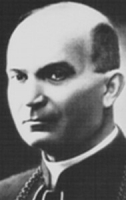





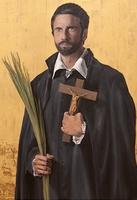
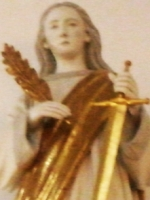
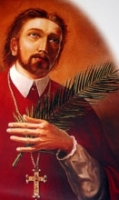
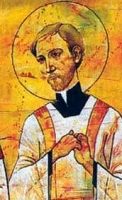



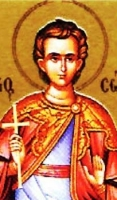

No comments:
Post a Comment